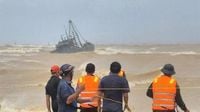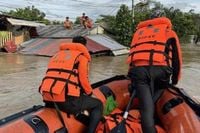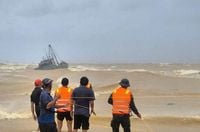Vietnam is facing one of its most severe weather threats in recent memory as Typhoon Bualoi barrels toward its central coast, prompting the government to enact sweeping emergency measures. On Sunday, September 28, 2025, authorities shut down four major coastal airports—including Danang International Airport—and ordered the evacuation of hundreds of thousands of residents, as the powerful storm approached with sustained winds of up to 133 km/h. The typhoon’s rapid pace and unexpected strength have left officials and communities scrambling to prepare for what meteorological agencies warn could be a multi-faceted disaster.
According to Viet Nam News, the government mobilized approximately 100,000 military personnel to assist in evacuation and disaster response, while local authorities began relocating at least 250,000 people from vulnerable areas. In Da Nang, the largest city in central Vietnam, more than 210,000 residents were being moved to safety, with over 32,000 in Hue and upwards of 15,000 in Ha Tinh also slated for evacuation. Schools in affected areas have closed, and further closures may be on the horizon as the storm’s impact zone widens.
The urgency is palpable. Deputy Minister Nguyen Hoang Hiep cautioned that Bualoi’s impact zone was “unusually wide, with strong winds and heavy rain expected to stretch from Ninh Bình in the north down to Hà Tĩnh in central Vietnam.” He added that the storm is “moving extremely fast and becomes stronger as it nears the shore,” raising the specter of storm surges, flash floods, landslides, and widespread coastal inundation. The National Civil Defence Steering Committee has instructed local governments not to underestimate the storm’s reach, especially in flood- and landslide-prone districts.
Already, the typhoon’s outer bands have brought heavy rain and flooding to cities such as Hue and Quang Tri, with reports of low-lying streets submerged and roofs torn from homes. In Quang Tri’s coastal waters, two fishing vessels were caught in the storm: one sank and the other was left stranded. Eight crew members were rescued, but three remain missing, according to AFP and state media. Local authorities in Quang Tri mobilized more than 200 people, along with trucks, sandbags, and bamboo stakes, to reinforce the coastline in a race against time.
“This is a rapidly moving storm—nearly twice the average speed—with strong intensity and a broad area of impact. It is capable of triggering multiple natural disasters simultaneously, including powerful winds, heavy rainfall, flooding, flash floods, landslides, and coastal inundation,” the national weather forecast agency warned, as reported by The Economic Times.
Vietnam’s Civil Aviation Authority suspended operations at four coastal airports starting Sunday, including Danang International Airport, and rescheduled several flights. All fishing boats in the typhoon’s path were ordered back to harbor, and border guards warned nearly 68,000 fishing boats with more than 286,000 crew to stay clear of the storm. In Thanh Hoa province, a fishing ban was imposed, and local leaders were told to ensure no one remained on boats during landfall.
Tourism has also ground to a halt. Da Nang and other coastal resort areas closed beaches and banned visitors for safety reasons, while authorities in Thanh Hóa’s Sam Sơn urged tourists and businesses to evacuate coastal areas and suspend sea-based services. The moves are part of a broader effort to reduce risk from strong winds, large waves, and possible storm surges, which disaster officials warn could exceed one meter if Bualoi makes landfall at high tide.
The typhoon’s approach comes just days after it battered the Philippines, where at least 26 people were killed and 14 remain missing, according to the National Disaster Risk Reduction and Management Council. More than 2.7 million people across 738,000 families were affected, with over 163,000 seeking refuge in evacuation centers. The worst-hit regions included Bicol and Cagayan Valley, where thousands of homes were damaged and relief funds distributed to about 150,000 families. The storm struck shortly after Super Typhoon Ragasa, which left more than 20 dead in Taiwan and the Philippines and caused mass evacuations and widespread destruction.
Vietnam is no stranger to deadly storms. With a long coastline facing the South China Sea, the country is regularly hit by typhoons that bring devastating winds and flooding. Just last year, Typhoon Yagi killed around 300 people and caused $3.3 billion in property damage. In the first seven months of 2025 alone, more than 100 people were killed or went missing in Vietnam due to natural disasters, according to the Ministry of Agriculture and Rural Development. In July, a tourist boat capsized in Ha Long Bay during a sudden thunderstorm, killing at least 37 people.
What makes Bualoi particularly alarming is its speed and potential for compounding hazards. Truong Ba Kien, deputy director of the Center for Meteorological and Climate Research, explained to VN Express that “a strong subtropical high is acting like a conveyor belt, keeping the storm on a fast and stable track.” Warm seas and calm atmospheric conditions are helping it maintain strength, and scientists warn this rare combination could allow Bualoi to intensify even further before landfall. If the storm’s arrival coincides with high tide, the risk of severe storm surges along the central coast will be extreme.
Climate experts say storms like Bualoi are becoming stronger and wetter as global temperatures rise. Warmer oceans provide tropical cyclones with more fuel, resulting in higher wind speeds and heavier rainfall. “Global warming is making storms like Bualoi stronger and wetter,” experts told The Independent, echoing broader scientific consensus that East Asia’s storm season is becoming increasingly unpredictable and dangerous.
Meanwhile, in Ho Chi Minh City, officials warn that severe rainfall could trigger urban flooding in neighborhoods with poor drainage, potentially disrupting traffic and daily life. The National Center for Hydro-Meteorological Forecasting has extended heavy rain warnings through October 1, with the heaviest downpours expected between Quảng Bình and Hà Tĩnh. Emergency teams remain on alert for flash floods and landslides in mountainous districts, while hydropower dams and river basins face heightened risks from the deluge.
As Bualoi’s center approached about 170 km east of Hue on Sunday morning, carrying winds of 118-133 km/h, the sense of urgency grew. Prime Minister Pham Minh Chinh called for the “highest level of readiness” as Bualoi entered Vietnam’s waters, urging local leaders to act decisively and ensure the safety of all residents. “I feel a bit anxious but still hopeful that everything will be fine in the aftermath. We were all safe after the recent typhoon Kajiki. I hope this one will be the same or less severe,” Nguyen Cuong, a 29-year-old resident of Ha Tinh City, told AFP.
With airports closed, fishing boats grounded, and hundreds of thousands evacuated, Vietnam is bracing for the full impact of Typhoon Bualoi—a storm whose speed, strength, and unpredictability have left a nation on edge and a region reminded yet again of the mounting risks posed by a warming world.



